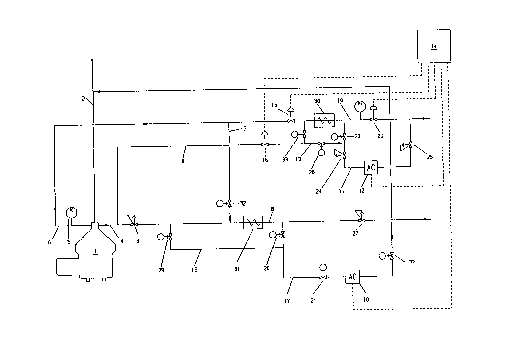Some of the information on this Web page has been provided by external sources. The Government of Canada is not responsible for the accuracy, reliability or currency of the information supplied by external sources. Users wishing to rely upon this information should consult directly with the source of the information. Content provided by external sources is not subject to official languages, privacy and accessibility requirements.
Any discrepancies in the text and image of the Claims and Abstract are due to differing posting times. Text of the Claims and Abstract are posted:
| (12) Patent: | (11) CA 2153666 |
|---|---|
| (54) English Title: | PROCESS AND SYSTEM FOR REGULATING THE FAT CONTENT OF MILK AND CREAM |
| (54) French Title: | METHODE ET SYSTEME POUR AJUSTER LA TENEUR EN MATIERES GRASSES DU LAIT ET DE LA CREME |
| Status: | Term Expired - Post Grant Beyond Limit |
| (51) International Patent Classification (IPC): |
|
|---|---|
| (72) Inventors : |
|
| (73) Owners : |
|
| (71) Applicants : |
|
| (74) Agent: | KIRBY EADES GALE BAKER |
| (74) Associate agent: | |
| (45) Issued: | 1999-03-23 |
| (86) PCT Filing Date: | 1993-11-11 |
| (87) Open to Public Inspection: | 1994-08-04 |
| Examination requested: | 1996-10-09 |
| Availability of licence: | N/A |
| Dedicated to the Public: | N/A |
| (25) Language of filing: | English |
| Patent Cooperation Treaty (PCT): | Yes |
|---|---|
| (86) PCT Filing Number: | PCT/EP1993/003162 |
| (87) International Publication Number: | EP1993003162 |
| (85) National Entry: | 1995-07-11 |
| (30) Application Priority Data: | ||||||
|---|---|---|---|---|---|---|
|
Whole milk is separated in a centrifuge into cream with
high fat content and skimmed milk. The composition of these
two components is kept constant. In order to produce a
standardized cream and a standarized milk, the skimmed milk is
mixed with cream and the cream with high fat content is mixed
with skimmed milk by regulating means. As the composition of
the mixed components is not influenced by ulterior regulating
processes, a reciprocal influence of the regulating processes
is avoided.
Dans la centrifugeuse, le lait entier est séparé en crème riche en matières grasses et en lait non gras. La composition de ces deux éléments est maintenue constante. Pour produire une crème et un lait standardisés, le lait non gras est mélangé à de la crème, et la crème riche en matières grasses à du lait non gras. La composition des éléments ajoutés n'est pas influencée par les processus de réglage aval, ce qui évite toute interaction des processus de réglage.
Note: Claims are shown in the official language in which they were submitted.
Note: Descriptions are shown in the official language in which they were submitted.

2024-08-01:As part of the Next Generation Patents (NGP) transition, the Canadian Patents Database (CPD) now contains a more detailed Event History, which replicates the Event Log of our new back-office solution.
Please note that "Inactive:" events refers to events no longer in use in our new back-office solution.
For a clearer understanding of the status of the application/patent presented on this page, the site Disclaimer , as well as the definitions for Patent , Event History , Maintenance Fee and Payment History should be consulted.
| Description | Date |
|---|---|
| Inactive: Expired (new Act pat) | 2013-11-11 |
| Grant by Issuance | 1999-03-23 |
| Inactive: Final fee received | 1998-12-02 |
| Pre-grant | 1998-12-02 |
| Notice of Allowance is Issued | 1998-06-09 |
| Notice of Allowance is Issued | 1998-06-09 |
| Letter Sent | 1998-06-09 |
| Inactive: Application prosecuted on TS as of Log entry date | 1998-06-03 |
| Inactive: Status info is complete as of Log entry date | 1998-06-03 |
| Inactive: Approved for allowance (AFA) | 1998-04-29 |
| Request for Examination Requirements Determined Compliant | 1996-10-09 |
| All Requirements for Examination Determined Compliant | 1996-10-09 |
| Application Published (Open to Public Inspection) | 1994-08-04 |
There is no abandonment history.
The last payment was received on 1998-10-22
Note : If the full payment has not been received on or before the date indicated, a further fee may be required which may be one of the following
Patent fees are adjusted on the 1st of January every year. The amounts above are the current amounts if received by December 31 of the current year.
Please refer to the CIPO
Patent Fees
web page to see all current fee amounts.
Note: Records showing the ownership history in alphabetical order.
| Current Owners on Record |
|---|
| WESTFALIA SEPARATOR AKTIENGESELLSCHAFT |
| Past Owners on Record |
|---|
| KARL-HEINZ ZETTIER |